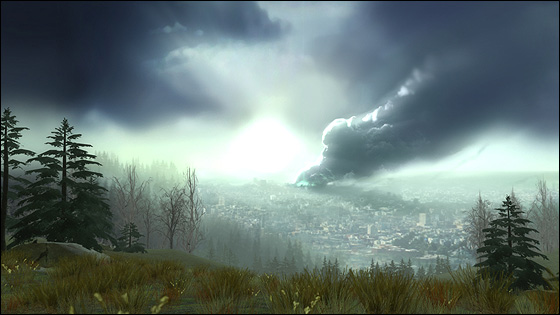Half-life: Episode Two Commentaries
July 11th, 2009

If you’ve followed my other articles about the Half-life series up till now then my reaction to Half-life: Episode 2 might not be such a huge surprise. To quickly retrospect; Half-life is the aged original, primitive and wonky by today’s standards, but no less a cornerstone for the industry. The implicit storytelling, large, interconnected world and seamless narrative were revolutions in design at the time, establishing the franchise’s high pedigree, yet beneath all the narrative kicks, Half-life was a relatively vanilla first person shooter. Half-life 2 is the critically acclaimed band-aid solution; an amalgamation of the same uninteresting first person gameplay mixed with nifty, albeit inconsistent and tacky, distractions. These distractions segment the various chapters of the game (ie. gravity gun for this area, antlion bait for another) making the title feel like a circus of discrepant ideas glued together, still not enough overcome the lethargic gameplay, as made embarrassingly apparent by the early sections of the game. Episode One tore away from the Half-life 2‘s fragmented approach to gameplay, focusing on diversifying set pieces and minor confrontations. Partner Alyx played her part as an individual catalyst for rejigging the former framework. She worked (and still works) better as a narrative piece than an instrument for the gameplay. While breaking away from Half-life 2‘s cheap thrills, Episode One was an unrealized remix of Half-life 2, which is where Episode Two enters.
Episode Two is not a complete realization of Episode One‘s breakaway, it’s maybe 75% of the way towards thrilling but never quite hits the spot. Still, in comparison to Half-life 2, Episode Two represents a marked improvement, a highlight in the series. Think of it as Episode Two as a streamlined version of Half-life 2, set in a completely original environment.

The last point is something that will immediately standout to continuing players. Instead of trawling the European-esque cityscapes of City17, Gordon is now out in the wilderness. This new environment is lovingly crafted with a fine layer of grandiosity characterizing the environment in Valve’s signature style. The new visual aesthetic is teamed with some impressive improvements in graphical fidelity to the Source engine, making for another visually striking entry in the series. The new style is well suited to the episodic format as it’d likely lose flavour if it were drawn out any longer. It’s aided by locales that splinter away from the Alaskan-themed forestry. Gordon is rather preemptively thrown into a series of underground catacombs, shifting gears almost from the journey’s get-go. Once he is reacquainted with the over world, the rest of the game plays out above ground, save for the interior areas of White Forrest and a scattering of small towns, outposts and camps along the way. Each of these pit stops, these changes in location, have two functions. The first is to allow the game to visually chew its food and never become to entrenched in the one aesthetic or colour scheme. Gameplay-wise the environments stake off familiarity and grind, provide their own inherent challenges for play. The caves are claustrophobic playing areas, inhabited by menacing Ant Lion Guards yet balanced by the abundance of sticky glowworms which heal Gordon’s health and light up the glossy interiors. The wilderness areas are large and expansive, allowing for Hunters to give chase or offering enough room for Gordon to drive a car around. Set piece events, such as the final defense of the White Forrest station are suited and designed around their locales. As such the environments appropriate the confrontations, ie. the crux of the game. Already we can observe how the design has been re-centred on the environment and not whatever gimmick at hand.
You see, the gimmicks employed in Half-life 2 now conglomerate to form the start-game toolset for the episodes. Some of them are sacrificed (antlion bait), some reapplied (squad-based gameplay) and others made default (gravity gun) – Valve have streamlined the experience which inevitably forces them to redesign the crux of the the episode’s design; the moment-to-moment gameplay. Meaning that since they now have a decent base to work with and Valve can finally begin to design a decent first person shooter, which Episode Two is the first of.
Additional Readings



 Game Design Companion: A Critical Analysis of Wario Land 4 - $7.99
Game Design Companion: A Critical Analysis of Wario Land 4 - $7.99 Level Design: Processes and Experiences
Level Design: Processes and Experiences Speed Boost: The Hidden Secrets Behind Arcade Racing Design - $5.99
Speed Boost: The Hidden Secrets Behind Arcade Racing Design - $5.99 Adventures in Games Analysis: Volume I - $5.99
Adventures in Games Analysis: Volume I - $5.99







